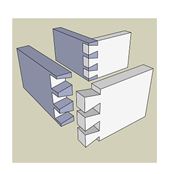I'd like to share a few methods that have enabled me to move from being almost entirely reactive in my work (simply fulfilling requests), to being proactive, where I have the ability to generate deliverables that will inform decision-making and drive strategy.
Several years ago, when I first began to learn about predictive analytics, I started out by reading books. The concepts in these books seemed almost unattainable to me. My organization at that time had just become a client of a consulting firm. We were very excited about adopting these ideas and methods, and the first thing the consultant asked me to provide him with, was a list of variables, attached to a random sample of IDs from our database. It actually took me a couple of days to make that file. And after that, there was at least another day’s worth of effort of data prep involved, as the consultant and I recoded those variables into binary flags in SPSS, so that we could even begin to run a regression and develop some models.
Fast forward a few years. I found myself in a position where I was suddenly supporting dozens of different areas. I developed processes to help me provide deliverables in a reasonable amount of time. After I had done this, my work life became much easier. I realized I should have been establishing these kinds of shortcuts in the first place. This should have been the first step.
We need to be in a position to quickly answer the questions that our colleagues ask us about our data. We also need to be in a position to quickly fulfill our own curiosity. We can only do this if the data is in a format that is readily available.
This is something that doesn’t tend to be discussed in books I’ve read about statistics or analytics. But it’s absolutely critical to be able to act on ideas, and to answer the questions that are relevant to business needs.
ART AND SCIENCE
In discussing our work, we hear a lot about this dichotomy of the art and science of fundraising, because it applies, right?
The C suite embodies the art of fundraising. Executives, gift officers and administrators use their experience and knowledge to guide the process. Programmers, researchers, and data scientists reveal trends in the data, and their explorations are similar to those of a scientist, who runs tests to determine validity. These activities work together to (hopefully) form essential symbiosis in organizations.
CRAFT
We hear a lot about the art and science of fundraising, but I believe there is a third essential concept not often mentioned. And this is where the work of the business analyst comes in. A successful business analyst bridges the gap between art and science.
I think of the business analyst as embodying “craft.” There is a technical aspect to craft, as well as an artistic aspect to it. The artful aspect involves knowing what to communicate, and how. It also involves knowing about data, and how to transform it from raw data into workable data. I talk about these concepts or activities as different roles. But in many organizations, different roles can (and often will) be fulfilled by a single person.
DATA TEMPLATES
Not so long ago, I picked up a new hobby, doing woodworking. My goal was to build a guitar. I had never owned any woodworking tools before. I didn’t know how it was done. My image or idea of a woodworker, was that they would just measure and cut boards and fit them together. *Or*, that they would just carve on things until the wood had the shape that they wanted. I didn’t ever think this work was easy, I just imagined them going slowly in order to attain the result that they desired. I didn’t think there was much more to it, than that.
But once I got into it, and I began to learn more about it, I realized that woodworking craftsmen will use all kinds of templates, or shortcuts. Woodworkers call these things “jigs.” These templates will help make their work be precise as well as repeatable. It also reduces risk of failure, and it helps them to be very exact in a short amount of time. Sometimes they will execute many complicated steps of a process very quickly.
To a woodworker, the risk is to ruin their resources, the wood, which can be very expensive. In much the same way, we as analytics practitioners don’t have unlimited time or employees to spend working on our projects.
As time went by, and I began to meet more experienced guitar builders, one thing that I noticed, is that all of the good ones had unique and creative solutions to universal problems. They also made their own tools and templates. How fascinating this was to me! These homemade solutions always served as time-saving patterns to help or assist them in crafting a final product, a product which hopefully:
(a) will produce minimal waste,
(b) is executed in a timely manner and
(c) has a slim, or no chance of failure. Because no one can afford to fail!
Just like an experienced woodworking craftsman, I sought to leverage my effectiveness by being nimble with data. It should not take as long (or longer) than a half a day to make a table, before we can even get started. We need to have the ability to fulfill our own (as well as others’) curiosity very quickly.
So I began to adopt the same approach in my work as a business analyst
Data templates can help us move from reactivity to proactivity.
BUILDING A DATA MART
I realize that the idea of building a data mart, which we will use as a basis for most of our analytics work, is not a new one, and you’ve most likely heard of it before. A transactional database is full of individual records, not summary data. A data warehouse contains multiple subject areas and can feed dimensional models.
A data mart serves one particular subject area. What I am proposing is that we put a lot of thought into a data mart. Build it so that you can run descriptives and summarize your entire population of people with it, or any segment within. Build it so that it contains all the independent variables you will ever need to build a predictive model. Put key metrics in it, which are central to your organization or business. If your VP asks for a statistic that you can’t provide quickly, add it to the data mart. The data mart should be your life line.
DATA MART EXAMPLE
Here’s an image that shows a few records from an example analytics data mart. This segment has been opened in excel. I don’t recommend housing a data mart in excel. Purely for the sake of example, I’ve given you a link here to an example excel file to download, containing sample data, just so that you can see. Your data mart should be query-able, which is something that excel will not do. In a smaller organization it will be perfectly fine to house your data mart in a tool like MS Access.
In this data mart, I’ve populated it with as many relevant binary flags or variables as I could possibly fill it with. If I’m given a list of people that anyone is curious about, I can add up these flags and produce descriptive statistics very quickly. For example, maybe 100 people went to your event. If you have the IDs of these people, I could then give you the percentage of alumni, current donors, lapsed donors, average age, and other summarized information about this group of people in a few minutes. I could also tell you much more about them. This is not revolutionary, but the point is, that I want to be nimble with data and I want to be able to provide quick response to curiosity. This solution enables that. I also would like for you to notice how I’ve used full words in my data. When I pivot on these values, my query results will be presentable, and will also have titles that don’t look like abbreviations or have unsightly underscores or computer-y characters in them.
CALCULATED VARIABLES
I’ve also put calculated or combined variables in this data mart. These are fields that I’ve had to do some creative coding with, in order to come up with a piece of information that isn’t simply extracted from a database or data warehouse, but is now easily extracted from the data mart. For example, Acquisition Age is intriguing to me and I intend to test it more. It is the age at which someone made their first gift.
Another kind of calculated variable to use, are those that quantify two or more related characteristics into a composite score, such as Affinity (or Engagement). Engagement could be calculated with a dependent variable that is collected by a survey of your staff, collecting the names of the most highly engaged individuals to your institution. You would then use this variable to train a model in order to reveal the relative engagement of your entire population. Another way to measure engagement would be to summarize key connection factors in your database and add them all up, like a score.
Another calculated variable is a simple yes/no, for whether or not an individual is an executive in a company or corporation. I have found this to be a very significant piece of information. Another is Donor Lifetime Value, the net amount you can expect someone to give during the course of their lifetime. We have all heard of RFM, or RFV (Recency, Frequency, Monetary Value), which is very important. Another powerful metric is one that measures recency in giving, where you would take the last 5 years giving total, and divide by the lifetime giving total. This would tell you very quickly what percentage of giving, any individual has made in the last 5 years.
And, of course, anything that can be quantified, can be segmented. Different strategies can be devised which effectively deal with each segment. And almost no work has to be done to do this segmentation, if the data mart is refreshed routinely, and the metrics are tracked.
FORECASTING
Another thing that a data mart can allow you to do more easily, is in the realm of forecasting. This is a great quick example to show how even very simple metrics can inform strategy. I purposely have flags for the last 5 full fiscal years so that I can forecast retention rates for the upcoming fiscal year.
A natural complement to this is a recency/frequency index which can be used to segment potential donors you want to target into more engaged, and less engaged populations.
My data mart flags are for overall giving. If I want to do a similar analysis that is more specific to a certain area of giving, I just use the query which produced the flags. I filter on any fund or allocation. With templates I have set up, I can then forecast for these more specific giving areas, very easily and quickly.
I hope that you will find some benefit to these ideas. I’ve put a lot of work in the last year or so, to reducing the pain of data preparation. I believe it has been worth it. The important thing is to not spend excessive time preparing data. I want my data preparation to be as painless as possible. I do this so that I can get to what really matters, the analysis and the insights that should follow.





